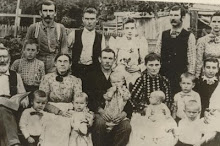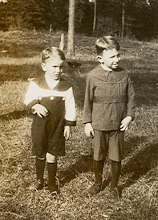Dr. V.M. Holland M.D.: The Life of My Husband,an East Texas Country Doctor,
by Mrs. V.M. Holland, Evangeline Neal Dennard Holland, R.N., Captain US Army WWII
Trans-scripted letter posted by Fred L. Holland, entitled "Virgil M. Holland, V.M. Holland, M.D"., dated 4 March 1995
Virgil Holland was born in Fairplay, Panola County, Texas, on 4 March 1918. His parents were Lois Allison Holland of Fairplay, Texas and Mordie Holland of Benton County and Carol County, Tennessee. Virgil had one sister, Marguerite, and three Brothers, Samuel, Leland, and James (known as “Bill”) Holland. His Father was a farmer, rancher and carpenter. His mother was a homemaker. Both parents were life long community leaders in the Methodist Church, local schools, county fairs, soil conservation, home demonstrations, and youth socials and activities.
Virgil attended the rural school in Fairplay and graduated from from Carthage High School in 1934. Only 11 years of public schooling was required for graduation at that time, and he had been advanced two grades. He was valedictorian and only 15. After graduation, he enrolled in the Baptist College of Marshall in Marshall, Texas. His Uncle Sam Allison paid his tuition and book fees: he paid his room and board by waiting on tables and washing dishes in the college cafeteria, managed by Mrs.Fant, mother of the Mayor of Shreveport, Louisiana, Mr. Clyde E. Fant. [ Mayor Clyde Fant would be the guest speaker at the CHS graduation commencement of Virgil’s son, Frederick Leon Holland, in 1971.]
According to Wikipedia,
Clyde Fant was a native of Linden in Cass County, Texas. He was one of six children of Mr. and Mrs. John Preston Fant. John Fant was a cotton gin owner and a onetime Texas state legislator. Fant graduated in 1925 from the former Marshall (Texas) College, now East Texas Baptist University. He taught school for a year in Blocker, a since abandoned community near Marshall, the seat of Harrison County. He then worked for a lumber company in east Texas and was thereafter associated with Southwestern Gas and Electric Company. He was an executive with Interstate Electric Company, with seven years of service with the firm, when he was transferred to Shreveport.]
Mrs. Fant was a lifelong friend and was admired and respected by her “helpers.”
Virgil was a “whiz” in math, chemistry, biology, physics, and history. This background provided good career choices and upon completion of enough hours for a teacher’s certificate and for graduation, he taught in the Fairplay School. He was a scholar, educator, hard worker, and teacher all of his adult life.
In May 1941, Virgil Mordie Holland joined the US Navy and served 4 years, 4 months, and 22 days. During those years of service, in Florida and California, and overseas on Guam and Australia, he was honorably discharged in 1945 as a Chief Pharmacist's Mate, (A.A.). It was during his WW II service that he decided his goal was to “ enter medical school after his discharge from the service, and to become a general practitioner (G.P.) of medicine after graduation and proper training.”
Virgil obtained a B.S. Degree through extra college work at Stephen F. Austin College, Nacogdoches, Texas. Graduating from there with honors, he was admitted to the University of Texas Medical School at Galveston, Texas without having to take an entrance exam in 1946. While there for four years of study, he worked at night for the Sisters of Charity and the John Sealy Hospital in Galveston. During the Summer, he “externed” at the Memorial Hospital in Henderson, Texas, and the Marshall Hospital in Marshall, Texas. In school, he was a member of a fraternity, living in their house and enjoying all their activities. Virgil graduated from the University of Texas Medical School in June 1950. He was third in his class of 96 and was admitted into Alpha Omega Alpha, the National Honor Medical Society.
The Texas Board of Medical Examiners granted Virgil M. Holland, B.S., M.D., this license to practice medicine in Texas in July 1950. Before the examination, he had taken time to marry Evangeline Dennard, Carthage I.S.D. public school’s first and only school nurse from 1947 - 1951. The couple felt they were very fortunate to be able to celebrate their 40th wedding anniversary together, before his death in 1990.
Dr. Holland interned at John Sealy Hospital in Galveston, Texas. Dr. Gregory, head of the Medical Department in the school wanted him to specialize in internal medicine and become an internal medical diagnostician. Dr. Holland was pleased to receive the offer, but he he felt it “would take too long and I wasn’t getting any younger.” He wanted to enter general practice, become a family physician, and fulfill his goal. He was a life [“Old Red”] member of the U.T. Galveston Medical School’s Alumni Association.
Upon completion of his John Sealy service, Dr. V.M. Holland had been offered a partnership to enter general practice at the Carthage Medical and Surgical Clinic in Carthage, Texas with Dr. Carl Prince and Dr. W.C. Smith: Mrs. V.M. Holland would continue to be the school nurse, but their plans had to change. Dr. W.C. Smith notified Dr. V.M. Holland that the partnership had an obligation to take back their partner, Dr. James M. Ashby, who was returning from the Korean War. The office space that was to be Dr. V.M. Holland would instead be returned to Dr. Ashby.
Dr. Lynn Hooker, whose clinic was also on West Panola, wanted Dr. V.M. Holland to join his clinical practice: but there was not enough room to set up an immediate practice there. This emergency need was taken care of by Dr. D. B. Daniel graciously offering to rent an office to Dr. Holland at the Panola Clinic on North Daniel Street for solo general practice. This help at this crucial time, after years of study and work, was always appreciated by both Dr. and Mrs. Holland in the years that followed.
However, Dr. Holland desired to enter a group practice, and soon he received an offer to join Dr. Coy Stone and Dr. Alfred “Al” Menson in Hobbs, New Mexico. It was too good an offer to turn down. Mr. Q. M. Martin, Superintendent of Carthage Independent School District, promised to release Evangeline, if she could talk Lou Tatum, R.N. into becoming the school nurse for Carthage I.S.D. The rest became history for Lou Tatum and school nursing in Panola County!
(Hurray for Lou and Coach Tatum --- God Bless you! Always!)
-Evangeline, March 4, 1995
TO BE CONTINUED...







